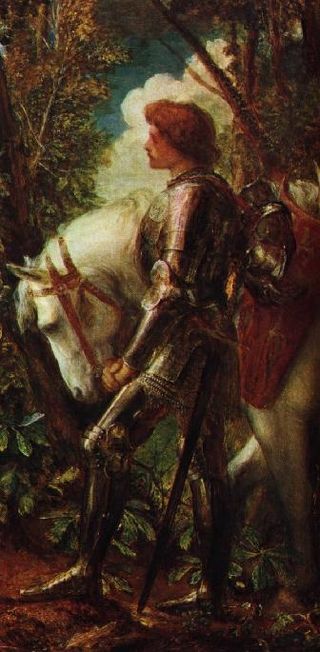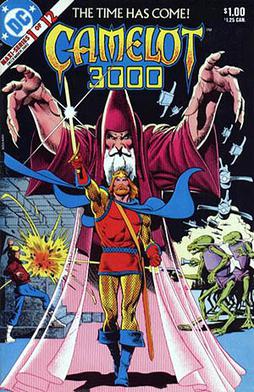
Excalibur is the mythical sword of King Arthur that may possess magical powers or be associated with the rightful sovereignty of Britain. Traditionally, the sword in the stone is the proof of Arthur's lineage. The sword given to him by the Lady of the Lake is not the same weapon, even though in some versions of the legend both of them share the name of Excalibur. Several similar swords and other weapons also appear within Arthurian texts, as well as in other legends.

Lancelot du Lac, alternatively written as Launcelot and other variants, is a popular character in Arthurian legend's chivalric romance tradition. He is typically depicted as King Arthur's close companion and one of the greatest Knights of the Round Table, as well as a secret lover of Arthur's wife, Guinevere.

Galahad, sometimes referred to as Galeas or Galath, among other versions of his name, is a knight of King Arthur's Round Table and one of the three achievers of the Holy Grail in Arthurian legend. He is the illegitimate son of Sir Lancelot du Lac and Lady Elaine of Corbenic and is renowned for his gallantry and purity as the most perfect of all knights. Emerging quite late in the medieval Arthurian tradition, Sir Galahad first appears in the Lancelot–Grail cycle, and his story is taken up in later works, such as the Post-Vulgate Cycle, and Sir Thomas Malory's Le Morte d'Arthur. In Arthurian literature, he replaced Percival as the hero in the quest for the Holy Grail.

The Lady of the Lake is a title used by multiple characters in the Matter of Britain, the body of medieval literature and mythology associated with the legend of King Arthur. As either actually fairy or fairy-like yet human enchantresses, they play important roles in various stories, notably by providing Arthur with the sword Excalibur, eliminating the wizard Merlin, raising the knight Lancelot after the death of his father, and helping to take the dying Arthur to Avalon after his final battle. Different Ladies of the Lake appear concurrently as separate characters in some versions of the legend since at least the Post-Vulgate Cycle and consequently the seminal Le Morte d'Arthur, with the latter describing them as members of a hierarchical group, while some texts also give this title to either Morgan or her sister.

Excalibur is a 1981 epic medieval fantasy film directed, cowritten and produced by John Boorman, that retells the legend of King Arthur and the knights of the Round Table, based loosely on the 15th-century Arthurian romance Le Morte d'Arthur by Thomas Malory. It stars Nigel Terry as Arthur, Nicol Williamson as Merlin, Nicholas Clay as Lancelot, Cherie Lunghi as Guenevere, Helen Mirren as Morgana, Liam Neeson as Gawain, Gabriel Byrne as Uther and Patrick Stewart as Leondegrance. The film is named after the legendary sword of King Arthur that features prominently in Arthurian literature. The film's soundtrack features the music of Richard Wagner and Carl Orff, along with an original score by Trevor Jones.

The Knights of the Round Table are the legendary knights of the fellowship of King Arthur that first appeared in the Matter of Britain literature in the mid-12th century. The Knights are an order dedicated to ensuring the peace of Arthur's kingdom following an early warring period, entrusted in later years to undergo a mystical quest for the Holy Grail. The Round Table at which they meet is a symbol of the equality of its members, who range from sovereign royals to minor nobles.

King Arthur is a 2004 epic historical adventure film directed by Antoine Fuqua and written by David Franzoni. It features an ensemble cast with Clive Owen as the title character, Ioan Gruffudd as Lancelot and Keira Knightley as Guinevere, along with Mads Mikkelsen, Joel Edgerton, Hugh Dancy, Ray Winstone, Ray Stevenson, Stephen Dillane, Stellan Skarsgård and Til Schweiger.

Bors is the name of two knights in Arthurian legend, an elder and a younger. The two first appear in the 13th-century Lancelot-Grail romance prose cycle. Bors the Elder is the King of Gaunnes (Gannes/Gaunes/Ganis) during the early period of King Arthur's reign, and is the brother of King Ban of Benoic and the father of Bors the Younger and Lionel. His son Bors the Younger later becomes one of the best Knights of the Round Table and participates in the achievement of the Holy Grail.

In Arthurian legend, the Siege Perilous is a vacant seat at the Round Table reserved by Merlin for the knight who would one day be successful in the quest for the Holy Grail.

Merlin is a 1998 two-part television miniseries starring Sam Neill as Merlin, recounting the wizard's life in the mythic history of Britain. Loosely adapted from the legendary tales of Camelot, the plot adds the antagonistic Queen Mab and expands Merlin's backstory before the birth of King Arthur.

Vengeance of Excalibur is a 1991 role-playing video game developed by Synergistic Software and distributed by Virgin Games. It is a sequel for Synergistic's 1990 title Spirit of Excalibur, set in Spain around the turn of the 10th and 11th Centuries. Vengeance of Excalibur puts the player in control of a small team of Knights of the Round Table who will seek out in Spain for the stolen items of the treasure of Camelot.

King Arthur and the Knights of the Round Table is a Japanese anime series based on Arthurian legend. Produced by Toei Animation, the series consists of 30 half-hour episodes released between 9 September 1979 and 3 March 1980. The series achieved great popularity in its non-English translations.

Camelot 3000 is an American twelve-issue comic book limited series written by Mike W. Barr and penciled by Brian Bolland. It was published by DC Comics from 1982 to 1985 as one of its first direct market projects, and as its first maxi-series. It was also the first comic book series to be printed on Baxter paper instead of newsprint.

King Arthur and His Knights of the Round Table is a retelling of the Arthurian legends, principally Thomas Malory's Le Morte d'Arthur, by Roger Lancelyn Green. It was intended for children. It was first published by Puffin Books in 1953 and has since been reprinted many times. In 2008, it was reissued in the Puffin Classics series with an introduction by David Almond, and the original illustrations by Lotte Reiniger.

Arthur Rex: A Legendary Novel is a 1978 novel by American author Thomas Berger. Berger offers his own take on the legends of King Arthur, from the heroic monarch's inauspicious conception, to his childhood in bucolic Wales, his rise to the throne, his discovery of the great sword Excalibur, his establishment of the Knights of the Round Table, his long and honorable reign, and his heroic death in battle against the evil Mordred, his bastard son.

Lancelot is a text adventure by Level 9 released in 1988. It has static graphics on some platforms. The plot focuses on Lancelot's quest to find the Holy Grail.

King Arthur(Arthur Pendragon) is a legendary figure used commonly in comic books.

The Bright Sword is a fantasy novel written by American author Lev Grossman, published in 2024 by Viking Press. The novel takes place within the King Arthur mythology, and follows a talented young knighted named Collum who travels from his backwater home to Camelot, expecting to meet King Arthur and join the Round Table. However, Collum finds the king died weeks ago, leaving only a handful of misfit knights to defend Camelot and the throne of Britain from competing warlords, rivals, and the magical forces of Morgan le Fay.


















